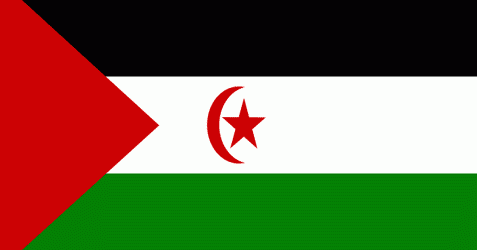“The Arab Spring actually began in autumn in a small camp in Western Sahara,” says Salka Barca. Barca doesn’t note that this fact is known by too few, but it is implied in a facial expression that is equal parts pride and exasperation.
In October of 2010, after years of stalemate over independence for a place described by Dr. Stephen Zunes, Professor of Politics and International Studies at the University of San Francisco, as “Africa’s last colony,” the season seemed right for change. The Sahrawi — people native to Western Sahara — launched a youth-driven tent city at Gdeim Izik to protest and assert their rights to self-determination. The youth were motivated, in particular, by years of what human rights groups have agreed is systematic repression of the Sahrawi by Morocco, as well as poor economic conditions and lack of job opportunity.
“It started as 12 or so tents,” says Barca, who, along with roommate Najat Allili, communicated with loved ones participating in the tent city from their home in Cincinnati. “Youth organized the camp, developed their own police and health centers. Tents had entertainment and children playing,” Barca adds.
The tent city continued for a month with between 7,000 and 20,000 people present, according to a Robert F. Kennedy Center for Justice and Human Rights report. The camp modeled non-violent principles championed by such Sahrawi leaders as Aminatou Haidar, often termed the Saharan Gandhi.
On Nov. 8, 2010, Moroccan security forces attacked the camp without warning. Violence at the camp and later in the Saharan capital of Laayoune was committed by both sides, according to Amnesty International, though its December 2010 report on the incident assigns primary blame to the methods employed by Morocco.
News coverage was scant in the U.S. and quickly forgotten with more focus on events in Tunisia in December, followed by Egypt in early 2011. Barca cheered the attention it received and was hopeful that awareness of what was being termed “Arab Spring” would make its way back to the starting point: Western Sahara. It never happened.
Western Sahara is the nation state that never quite happened.
“It was a former Spanish colony on the verge of independence,” says Zunes. Instead, it was taken over, with tacit Spanish approval, by Mauritania and Morocco in 1975. The Sahrawi resisted, and armed struggle was waged by the Popular Front for the Liberation of Saqiat al Hamra and the Rio de Oro — the Polisario.
Mauritania pulled out in 1979, but Morocco remained. And the fighting continued until a United Nations-facilitated ceasefire in 1991. At that time, negotiations between Morocco and the Polisario — which had established a government in exile from the Tindouf refugee camps in Algeria — were to result in a referendum to determine independence versus Moroccan rule. The referendum never quite happened, either.
U.N. efforts have failed to bring agreement on who is eligible to vote in a referendum. Meanwhile, Morocco has made it clear it intends to maintain sovereignty and has encouraged Saharan settlement by Moroccans to bolster its claim. Access to phosphate and fishing resources might be a motivator.
Barca spent her childhood in the Tindouf camps until she was sent to school. “I was crying like crazy,” she says of saying goodbye to her family. Sending children away from the harsh refugee conditions, she explains, was the best way parents could provide any chance of education, healthcare or safety. “There was always fear of Morocco bombing the camps.”
This is why Barca’s worst fears were realized when Moroccan forces moved in at Gdeim Izik. “It was horrifying. It was very emotional,” she says. “I went to work and was not functioning. I blamed myself for not being there — for hiding in America and running my mouth.”
Allili grew up in Laayoune. Her extended family includes aunts and uncles imprisoned for years for their resistance against Moroccan rule. She was a teenager in the early ’90’s when those that survived were released. “I remember every minute,” she says. “They were like skeletons, their clothes were from the 1970s.”
“At that time, I started understanding what had happened,” Allili says. Her commitment to Sahrawi freedom was formed.
Barca and Allili’s work toward this end includes use of social media to educate about Western Sahara and the translation of training materials for activists on non-violence. It is slow work made even more so by lack of global interest. A Congressional Research Service report from 2011 says, “Western Sahara was not high on the international political agenda and that most capitals seek to continue good relations with both Morocco and Algeria. Hence, they acquiesce the impasse.”
“They” includes the United States, which — while it has encouraged Morocco to address its human rights abuses against the Sahrawi — has maintained its support of the Moroccan monarchy.
There are moments when the Sahrawi cause makes itself known, however quietly. Allili, a student at Cincinnati State Technical and Community College, sees it in the international building on campus where flags highlight students from around the world.
“We listened to her,” says Yolanda Lawrence, International Student Advisor. “If students don’t see their flags they come to us and ask for them,” she explains. When they see their home flag it says, “I am here.”
Allili’s flag is now there. And it is the Sahrawi flag that represents her, not Morocco’s.
Barca sees it in the Occupy Movement’s use of the tent. “Tent is symbolic of resistance in Bedouin society,” she says. “It is symbolic of freedom and the natural life.”
“Their support of non-violence is key,” says Zunes of Barca and Allili. “Their role in the Sahrawi Diaspora is that the people need international support to help raise awareness.”
“The best hope for non-violence,” he continues, “is getting the story out.”
And so, at their computers, Barca and Allili work to make that happen, little by little, everyday. ©







0 comments:
Post a Comment